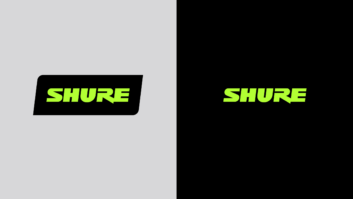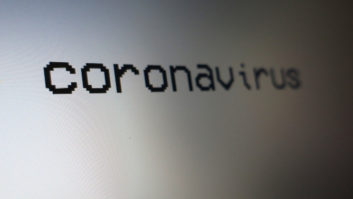Kevin Gage, executive vice president and chief technology officer for the National Association of Broadcasters, addressed the 67th annual Broadcast Engineering Conference during the spring NAB Show. Here are excerpts.

Kevin Gage. ‘For radio, we are strongly focused on advancing into the digital, handheld age.’
credit: Photo by Jim Peck A year ago, I challenged you — the technology leaders of the broadcasting industry — to join me and NAB in transforming our industry.
We are the original “wireless” industry, but we were not perceived to be wireless. We are the original social network of our local communities, but we were not perceived to be that. In the past year, many of you took up my challenge and joined me in leading our transformation.
Last year, we launched NAB Labs as a platform for broadcaster innovation and the NAB Labs technology teams that have lead this transformation. And as we meet here today, in an atmosphere of constant and accelerating change for our industry — one in which the stakes could not be higher — innovation and progress to a changing media technology landscape has become an essential, daily component of broadcasting, and a prerequisite for its continuance as a competitive consumer product.
The NAB Board acknowledged this when they championed the formation of NAB Labs to help drive this process for the industry, and in the past year, we’ve worked tirelessly to build momentum in that direction.
PROJECT REPORT
On both the radio and television sides of the business, NAB Labs has launched projects that we expect to have significant applicable impact on broadcasters’ future. For radio, we are strongly focused on advancing into the digital, handheld age.
One area in which we see strong promise is hybrid radio. We’ve defined and developed the technology, held meetings across the country and the world, brought previously separate communities together, and made investments to help this fledgling technology reach a tipping point.
We’ve also dug deep on the possibilities for AM radio’s revitalization. Again, we’ve studied the options and are taking steps to develop a multi-tiered strategy that will refresh the senior broadcast band and give it new life in the digital age. We’ve run tests on all-digital IBOC for AM, which has never been broadly tested, with promising initial results. More tests are planned on this soon, along with other exploration of possible options for AM broadcasting improvements.
On the TV side, where all things are already digital, we’re looking at the next generation of technology that can make television even more compelling, flexible and entertaining. Through the efforts of our members in the NAB Labs Television Technology Committee, we are exploring just what a next-generation broadcast TV platform should include, and taking steps to test these assumptions in real-world environments.
We know that television is quickly moving to a connected, multi-platform, multi-screen environment … and we want to ensure broadcasters’ place in this new world. NAB Labs will leave no stone unturned in that quest, and in fact, we expect to get out ahead of the development curve.
So … We’ve made some new connections with industry groups that might have seemed unusual in the past, but we feel they are critical today, and will be even more so moving forward. NAB is now a member of W3C — the World Wide Web Consortium, which guides the development of new online applications.
We’ve joined ATIS — the Alliance for Telecommunications Industry Solutions — and through that membership have joined 3GPP, the body that sets standards for wireless telecommunications.
And along with our continuing leadership of ATSC and its ATSC 3.0 standards development, we remain involved on a global scale with FoBTV — the Future of Broadcast Television group.
NAB has also joined DVB, another worldwide digital television standards development organization that is pursuing next-generation solutions as well. Working with all of these bodies, and others we find appropriate in the future, will provide NAB Labs with the broadest possible vision of what’s next for television technology, and what path makes the most sense for broadcasters to pursue.
Our work in these new spaces will also provide opportunities to forge new partnerships — another key role that NAB Labs has been charged with. We’ve already worked with our radio members to help enable hybrid radio technology, and one application of those efforts is the recent announcement by Sprint that will result in millions of new FM receivers in smartphones.
We will seek out and explore other new affiliations, unorthodox though they may seem to be at first, as we establish our place within the “new normal” of the broadcasting business.
CONTENT DISCOVERY
A common thread among these emerging venues is the importance of content discovery. How do ever-increasing, fragmented audiences find the programs they want, in the forms and on the devices that they want them?
Traditionally, this was easy. Two knobs were all you needed: tuning and volume.
Today, it’s much more complex and competitive and becoming more so every day. We need to ensure that consumers can still find and enjoy broadcast content easily and quickly, on whatever device, or devices, they are using at the moment.
Another key attribute of any new technologies we select is how well they play to broadcasters’ strengths. The criterion of robustness and scalability is foremost among these.
We’ve seen many recent cases of communications systems’ failure in times of crisis, with only broadcasting remaining intact, and providing its critical lifeline service to affected users. Any new technologies we adopt will have to not only retain, but improve upon, this level of reliability, effectiveness and expanded emergency alerting capabilities, ensuring that broadcasters will continue to serve our local communities as their first informer in times of crisis.
An increasingly unique element of the service broadcasters provide is its localism.
Again, any new delivery systems we adopt must build upon this essential capability, and allow broadcasters to present both national and local content to their audiences. In fact, we should explore new technologies for their ability to provide even finer granularity for our services, targeting “hyper-local” audiences within a broadcast market and develop new ways to connect and build upon the trust relationship we have with our local communities.
The audiences we serve are also increasingly mobile, and they want their media content along for the ride. Radio has long been a mobile service, but we can make it even more pervasive with its inclusion on more handheld devices, and its expanded service to vehicles through hybrid radio techniques.
Meanwhile, as the first Mobile TV devices emerge, we are taking the first real steps toward adding mobility to our television services. Many more similar steps must follow.
We’ve also learned that our audiences are increasingly diverse, and they expect a greater degree of control over their media content. So our next-generation services must offer greater choice and interactivity. Of course, all this technology is worth nothing if we do not also identify and develop the new products and services that our consumers require and expect today.
ELEVATE INNOVATION
Personalized interactive services. Mobile services. Higher-quality services. “Service following” and discovery. Today’s consumer is more technologically demanding and savvy than any other era, and with our new platforms, we will have a new way to connect with them and meet their requirements and exceed their expectations.
As with HDTV, broadcasters will drive the bulk of innovation on these new areas, and the rest of the industry will follow. So many have said that broadcasters don’t innovate, but we know this is patently untrue. Yet we are now challenged to elevate our innovation to the next level, with expansive thinking that confronts traditional assumptions.
Our next-generation broadcast systems will require greater flexibility and agility than in the past, to meet unknown and ever-changing market dynamics and competition. While challenging such fundamental tenets of broadcasting may raise some eyebrows, it is necessary.
It is evolution, and we believe it is good business to revisit these long-held beliefs to see if they still have merit. But to do this, we will need to work together. Over the past year, the leadership assembled in this room has proven they are up to the task.
NAB Labs will continue to be the catalyst for these discussions, and the clearinghouse for your ideas. And when we, or others, make progress, we will share that information with you through the numerous channels of NAB Labs’ educational processes.
For over 90 years, NAB has been working with and for broadcasters to keep the industry strong. While none of us will probably be here 90 years from now, we can leave a platform for the next generation technology leadership to thrive on and be proud of.
It is within our power and, in fact, it is our obligation to build upon of work in 2012 and work together to define our own destiny.
We’re glad you’re here, and we want to continue to hear from you. Engage with us, and help us make NAB Labs a powerful vehicle for our mutual propulsion into the next generation of broadcasting.
Comment on this or any story. Email [email protected] with Letter to the Editor in the subject field.












